Decreased Landscape Ecological Security of Peri-Urban Cultivated Land Following Rapid Urbanization: An Impediment to Sustainable Agriculture
Abstract
:1. Introduction
2. Materials and Methods
2.1. The Study Area
2.2. Data Processing
2.3. Gridding in the Study Area
2.4. Landscape Metrics of Cultivated Land
- (1)
- Patch densitywhere PD is the patch density; N is the number of cultivated land patches located within the grid, and A is the total cultivated landscape area (km2).
- (2)
- Edge densitywhere ED is the edge density, P is the total length of perimeters for all cultivated land patches (km), and A is the total cultivated landscape area (ha).
- (3)
- Area-weighted mean shape indexwhere AWMSI is the area-weighted mean shape index, n is the total number of cultivated land patches, Pi is the perimeter of cultivated land patch i, Ai is the area of cultivated land patch i, and A is the total cultivated landscape area.
- (4)
- Fractal dimensionwhere FRAC is the fractal dimension, Pi is the perimeter of cultivated land patch i, and Ai is the area of cultivated land patch i.
- (5)
- Landscape division indexwhere DIVISION is the landscape division index; n is the total number of cultivated land patches; Ai is the area of cultivated land patch i; A is the total cultivated landscape area.
2.5. LES Assessment of Cultivated Land Resources
3. Results and Analysis
3.1. Loss of Ecological Land to Urbanization between 1990–2016
3.2. Variations in Fundamental Landscape Metrics of Cultivated Land
3.3. Spatiotemporalchanges of the Cultivated Landscape and Its Surrounding Landscape
3.4. LES Assessment Results of Cultivated Land in a Peri-Urban Area
4. Discussion
5. Conclusions
Acknowledgments
Author Contributions
Conflicts of Interest
References
- Costanza, R.; d’Arge, R.; de Groot, R.; Farber, S.; Grasso, M.; Hannon, B.; Limburg, K.; Naeem, S.; O’Neill, R.V.; Paruelo, J.; et al. The value of the world’s ecosystem services and natural capital. Nature 1997, 387, 253–260. [Google Scholar] [CrossRef]
- Li, F.; Zhang, S.; Yang, J.; Bu, K.; Wang, Q.; Tang, J.; Chang, L. The effects of population density changes on ecosystem services value: A case study in western Jilin, China. Ecol. Indic. 2016, 61, 328–337. [Google Scholar]
- Zander, P.; Groot, J.C.J.; Rossing, W.A.H.; Knierim, U. Multifunctionality of agriculture: Tools and methods for impact assessment and valuation. Agric. Ecosyst. Environ. 2007, 120, 1–4. [Google Scholar] [CrossRef]
- Su, W.Z.; Gu, C.L.; Yang, G.S.; Shuang, C.; Feng, Z. Measuring the impact of urban sprawl on natural landscape pattern of the western Taihu lake watershed, China. Landsc. Urban Plan. 2010, 95, 61–67. [Google Scholar] [CrossRef]
- Sun, D.F.; Hong, L.I.; Dawson, R.; Tang, C.J.; Xian-Wen, L.I. Characteristics of steep cultivated land and the impact of the grain-for-green policy in China. Pedosphere 2006, 16, 215–223. [Google Scholar] [CrossRef]
- Pribadi, D.O.; Pauleit, S. The dynamics of Peri-Urban agriculture during rapid urbanization of Jabodetabek metropolitan area. Land Use Policy 2015, 48, 13–24. [Google Scholar] [CrossRef]
- Ives, C.D.; Kendal, D. Values and attitudes of the urban public towards peri-urban agricultural land. Land Use Policy 2013, 34, 80–90. [Google Scholar] [CrossRef]
- Dunk, A.V.D.; Grêt-Regamey, A.; Dalang, T.; Hersperger, A.M. Defining a typology of peri-urban land-use conflicts—A case study from Switzerland. Landsc. Urban Plan. 2011, 101, 149–156. [Google Scholar] [CrossRef]
- Borgogno-Mondino, E.; Fabietti, G.; Ajmone-Marsan, F. Soil quality and landscape metrics as driving factors in a multi-criteria GIS procedure for peri-urban land use planning. Urban For. Urban Green. 2015, 14, 743–750. [Google Scholar] [CrossRef]
- Rolf, W.; Peters, D.; Lenz, R.; Pauleit, S. Farmland- An elephant in the room of urban green infrastructure? Lessons learned from connectivity analysis in German cities. Ecol. Indic. 2017. [Google Scholar] [CrossRef]
- Sheridan, H.; Keogh, B.; Anderson, A.; Carnus, T.; Mcmahon, B.J.; Green, S.; Purvis, G. Farmland habitat diversity in Ireland. Land Use Policy 2017, 63, 206–213. [Google Scholar] [CrossRef]
- York, A.M. Land fragmentation under rapid urbanization: A cross-site analysis of southwestern cities. Urban Ecosyst. 2011, 14, 429–455. [Google Scholar] [CrossRef]
- Sklenicka, P. Classification of farmland ownership fragmentation as a cause of land degradation: A review on typology, consequences, and remedies. Land Use Policy 2016, 57, 694–701. [Google Scholar] [CrossRef]
- Li, W.; Wang, D.; Li, H.; Liu, S. Urbanization-induced site condition changes of peri-urban cultivated land in the black soil region of Northeast China. Ecol. Indic. 2017, 80, 215–223. [Google Scholar] [CrossRef]
- Latruffe, L.; Piet, L. Does land fragmentation affect farm performance? A case study from Brittany, France. Agric. Syst. 2014, 129, 68–80. [Google Scholar] [CrossRef]
- Breed, M.F.; Gardner, M.G.; Ottewell, K.M.; Navarro, C.M.; Lowe, A.J. Shifts in reproductive assurance strategies and inbreeding costs associated with habitat fragmentation in Central American mahogany. Ecol. Lett. 2015, 15, 444–452. [Google Scholar] [CrossRef] [PubMed]
- Cerezo, A.; Conde, M.C.; Poggio, S.L. Pasture area and landscape heterogeneity are key determinants of bird diversity in intensively managed farmland. Biodivers. Conserv. 2011, 20, 2649–2667. [Google Scholar] [CrossRef]
- Vagneron, I. Economic appraisal of profitability and sustainability of peri-urban agriculture in Bangkok. Ecol. Econ. 2007, 61, 516–529. [Google Scholar] [CrossRef]
- Pölling, B.; Mergenthaler, M.; Lorleberg, W. Professional urban agriculture and its characteristic business models in metropolis Ruhr, Germany. Land Use Policy 2016, 58, 366–379. [Google Scholar] [CrossRef]
- Wästfelt, A.; Zhang, Q. Reclaiming localisation for revitalising agriculture: A case study of peri-urban agricultural change in Gothenburg, Sweden. J. Rural Stud. 2016, 47, 172–185. [Google Scholar] [CrossRef]
- Maheshwari, B.; Bristow, K.L. Peri-urban water, agriculture and urbanisation. Agric. Water Manag. 2016, 176, 263–265. [Google Scholar] [CrossRef]
- Shrestha, M.K.; York, A.M.; Boone, C.G.; Zhang, S. Land fragmentation due to rapid urbanization in the phoenix metropolitan area: Analyzing the spatiotemporal patterns and drivers. Appl. Geogr. 2015, 32, 522–531. [Google Scholar] [CrossRef]
- Jiao, L.; Xiao, F.; Xu, G.; Lu, Y. Spatial-temporal response of green land fragmentation patterns to urban expansion in Wuhan metropolitan area. Resour. Sci. 2015, 37, 1650–1660. (In Chinese) [Google Scholar]
- Turner, M.G.; Gardner, R.H. Quantitative Methods in Landscape Ecology; Springer: Dordrecht, The Netherlands, 1991. [Google Scholar]
- Pei, H.; Wei, Y.; Wang, X.; Qin, Z.; Hou, C. Method of cultivated land landscape ecological security evaluation and its application. Trans. Chin. Soc. Agric. Eng. 2014, 30, 212–219. (In Chinese) [Google Scholar]
- Inkoom, J.N.; Frank, S.; Greve, K.; Walz, U.; Fürst, C. Suitability of different landscape metrics for the assessments of patchy landscapes in west Africa. Ecol. Indic. 2017, 85, 117–127. [Google Scholar] [CrossRef]
- Li, Y.F.; Xiang, S.; Zhu, X.D.; Cao, H.H. An early warning method of landscape ecological security in rapid urbanizing coastal areas and its application in Xiamen, China. Ecol. Model. 2010, 221, 2251–2260. [Google Scholar] [CrossRef]
- Boyle, P.; Hayes, M.; Gormally, M.; Sullivan, C.; Moran, J. Development of a nature value index for pastoral farmland—A rapid farm-level assessment. Ecol. Indic. 2015, 56, 31–40. [Google Scholar] [CrossRef]
- Yu, X.; Wu, K.; Yun, W.; Wei, H.; Liu, L.; Song, Y.; Gao, X. Analysis on temporal and spatial variation of landscape ecological security in modern agricultural area. Trans. Chin. Soc. Agric. Eng. 2016, 32, 253–259. (In Chinese) [Google Scholar]
- Yang, W.; Guo, Y.; Wang, X.; Chen, C.; Hu, Y.; Cheng, L.; Gu, S.; Xu, X. Temporal variations of soil microbial community under compost addition in black soil of Northeast China. Appl. Soil Ecol. 2017, 121, 214–222. [Google Scholar] [CrossRef]
- Chen, X.; Wang, W.; Liang, H.; Liu, X.; Da, L. Dynamics of ruderal species diversity under the rapid urbanization over the past half century in Harbin, northeast China. Urban Ecosyst. 2014, 17, 455–472. [Google Scholar] [CrossRef]
- Bonfanti, P.; Fregonese, A.; Sigura, M. Landscape analysis in areas affected by land consolidation. Landsc. Urban Plan. 1997, 37, 91–98. [Google Scholar] [CrossRef]
- Muchová, Z.; Leitmanová, M.; Petrovič, F. Possibilities of optimal land use as a consequence of lessons learned from land consolidation projects (Slovakia). Ecol. Eng. 2016, 90, 294–306. [Google Scholar] [CrossRef]
- Skog, K.L.; Steinnes, M. How do centrality, population growth and urban sprawl impact farmland conversion in Norway? Land Use Policy 2016, 59, 185–196. [Google Scholar] [CrossRef]
- Wilson, W.L.; Abernethy, V.J.; Murphy, K.J.; Adam, A.; Mccracken, D.I.; Downie, I.S.; Foster, G.N.; Furnessa, R.W.; Waterhousec, S.; Ribera, I. Prediction of plant diversity response to land-use change on Scottish agricultural land. Agric. Ecosyst. Environ. 2013, 94, 249–263. [Google Scholar] [CrossRef]
- Araya, Y.H.; Cabral, P. Analysis and modeling of urban land cover change in Setúbal and Sesimbra, Portugal. Remote Sens. 2010, 2, 1549–1563. [Google Scholar] [CrossRef]
- Wu, J. Effects of changing scale on landscape pattern analysis: Scaling relations. Landsc. Ecol. 2004, 19, 125–138. [Google Scholar] [CrossRef]
- Marrugo-Negrete, J.; Pinedo-Hernández, J.; Díez, S. Assessment of heavy metal pollution, spatial distribution and origin in agricultural soils along the Sinú river basin, Colombia. Environ. Res. 2017, 154, 380–388. [Google Scholar] [CrossRef] [PubMed]
- Xu, X.; Zhao, Y.; Zhao, X.; Wang, Y.; Deng, W. Sources of heavy metal pollution in agricultural soils of a rapidly industrializing area in the Yangtze Delta of China. Ecotoxicol. Environ. Saf. 2014, 108, 161–167. [Google Scholar] [CrossRef] [PubMed]
- Bouma, J.; Droogers, P. A procedure to derive land quality indicators for sustainable agricultural production. Geoderma 1998, 85, 103–110. [Google Scholar] [CrossRef]
- Wu, Y.; Shan, L.; Guo, Z.; Peng, Y. Cultivated land protection policies in China facing 2030: Dynamic balance system versus basic farmland zoning. Habitat Int. 2017, 69, 126–138. [Google Scholar] [CrossRef]
- Morelli, F.; Jerzak, L.; Tryjanowski, P. Birds as useful indicators of high nature value (HNV) farmland in central Italy. Ecol. Indic. 2014, 38, 236–242. [Google Scholar] [CrossRef]
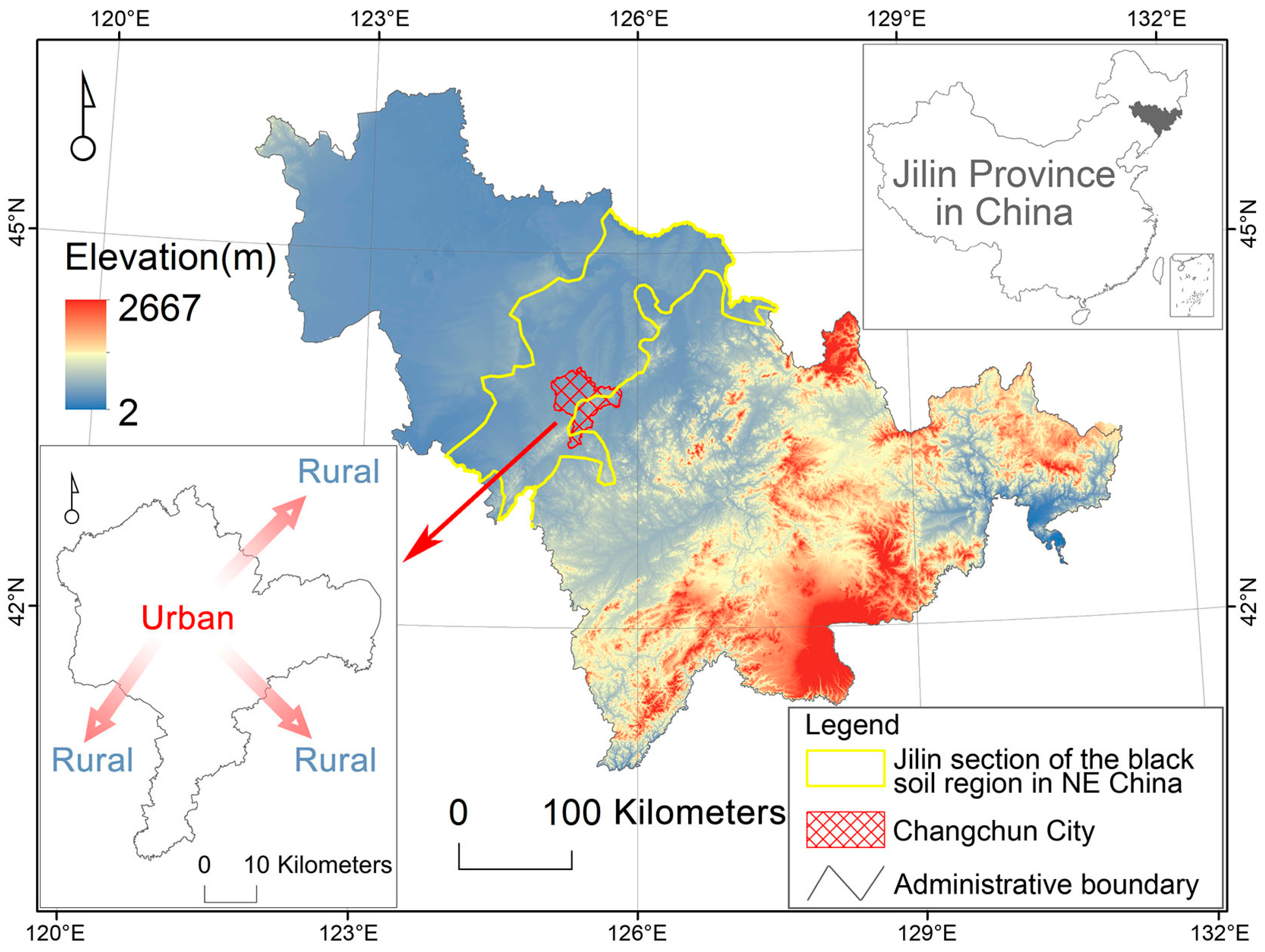
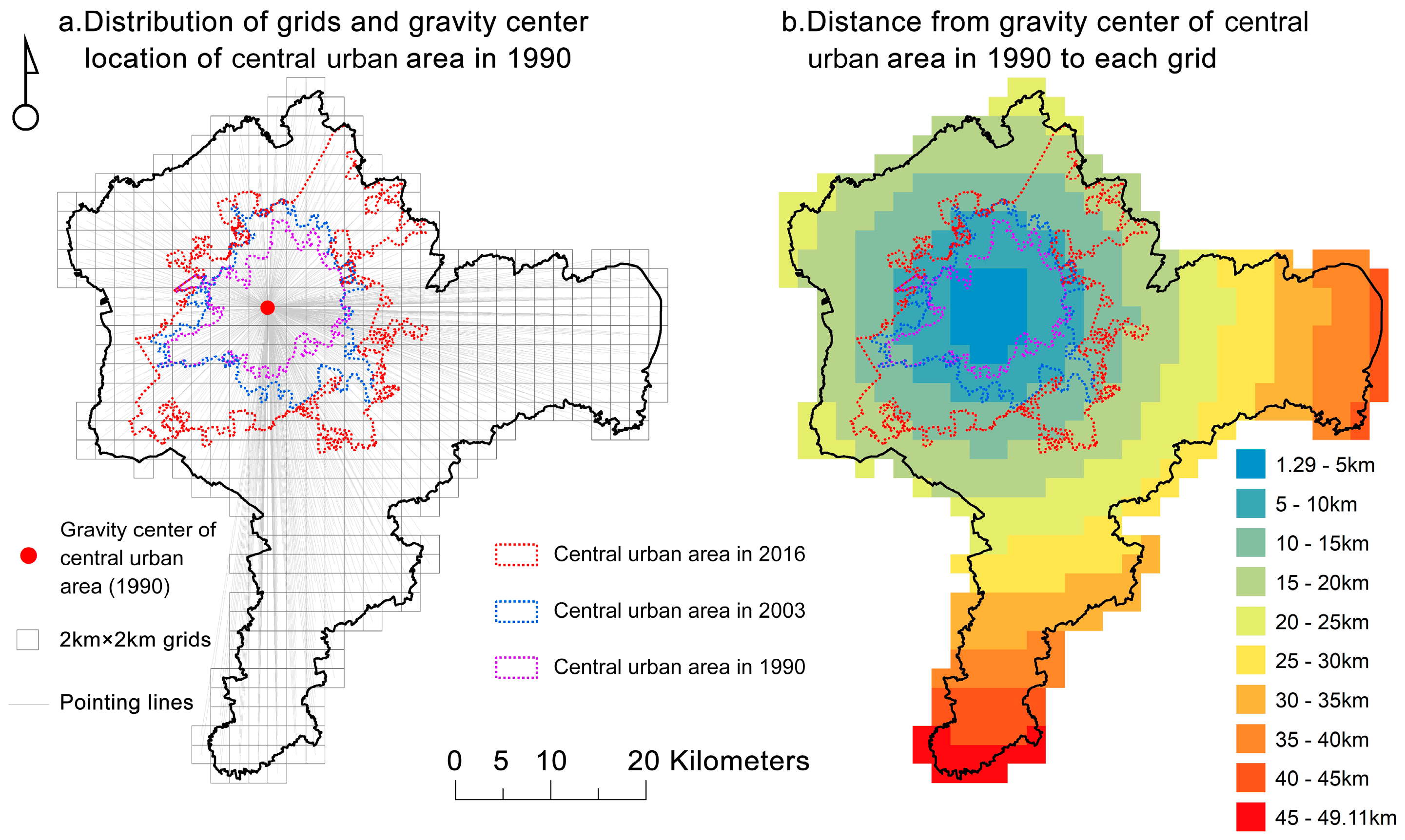
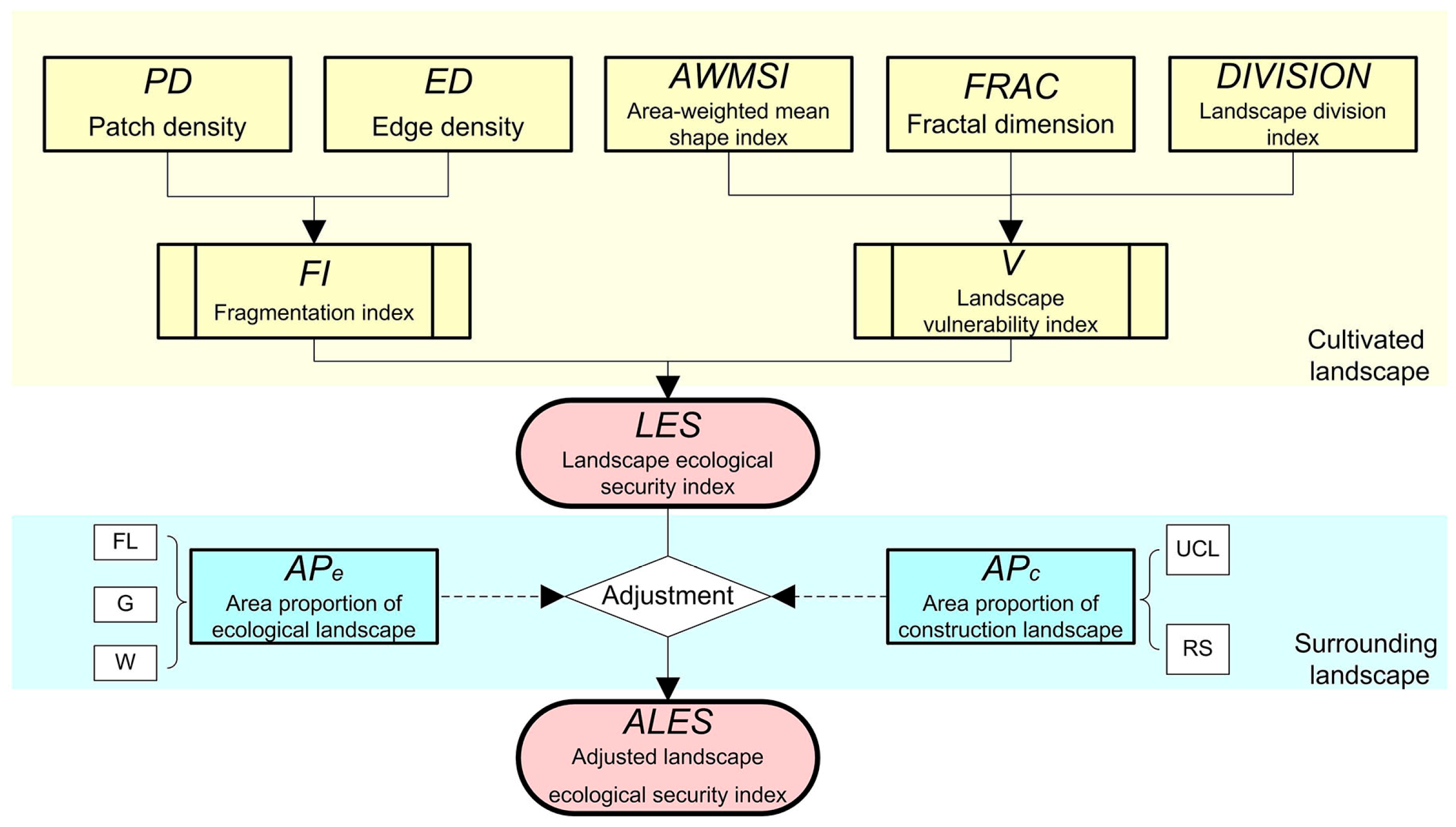
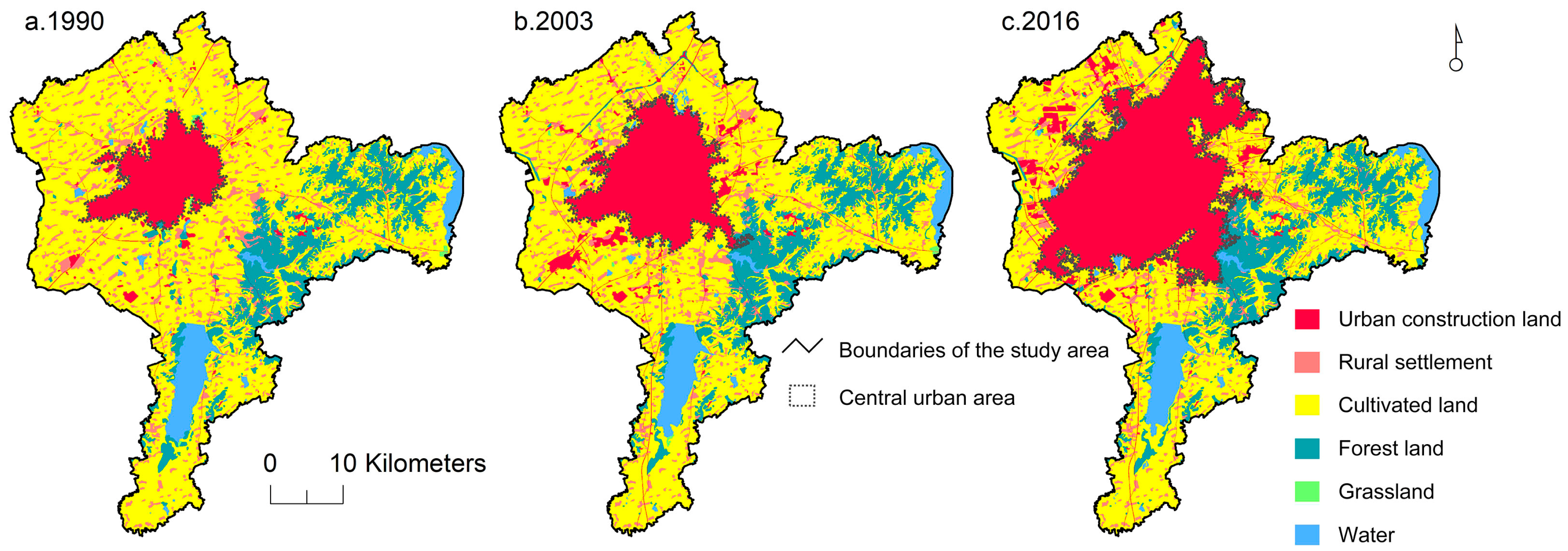
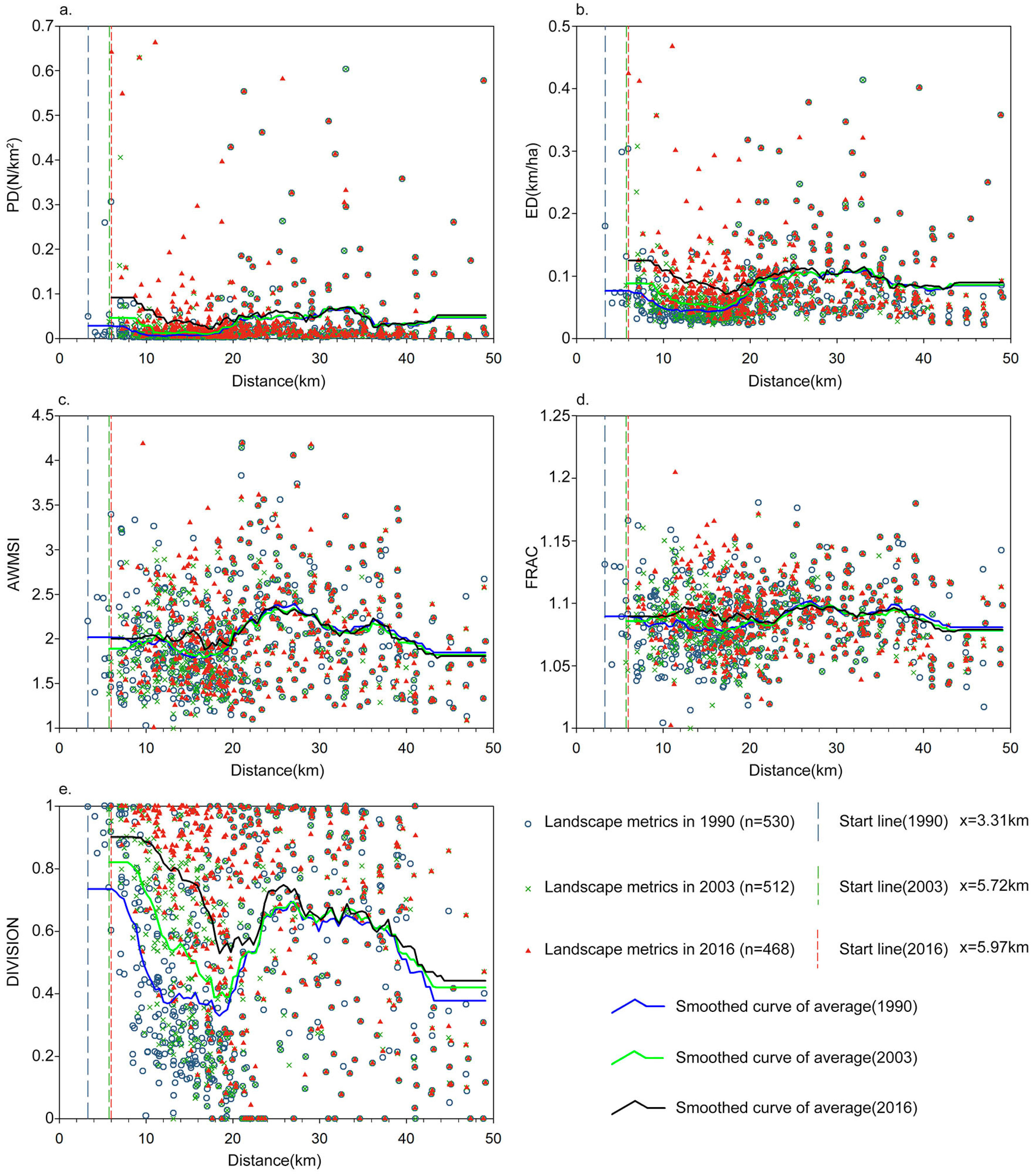
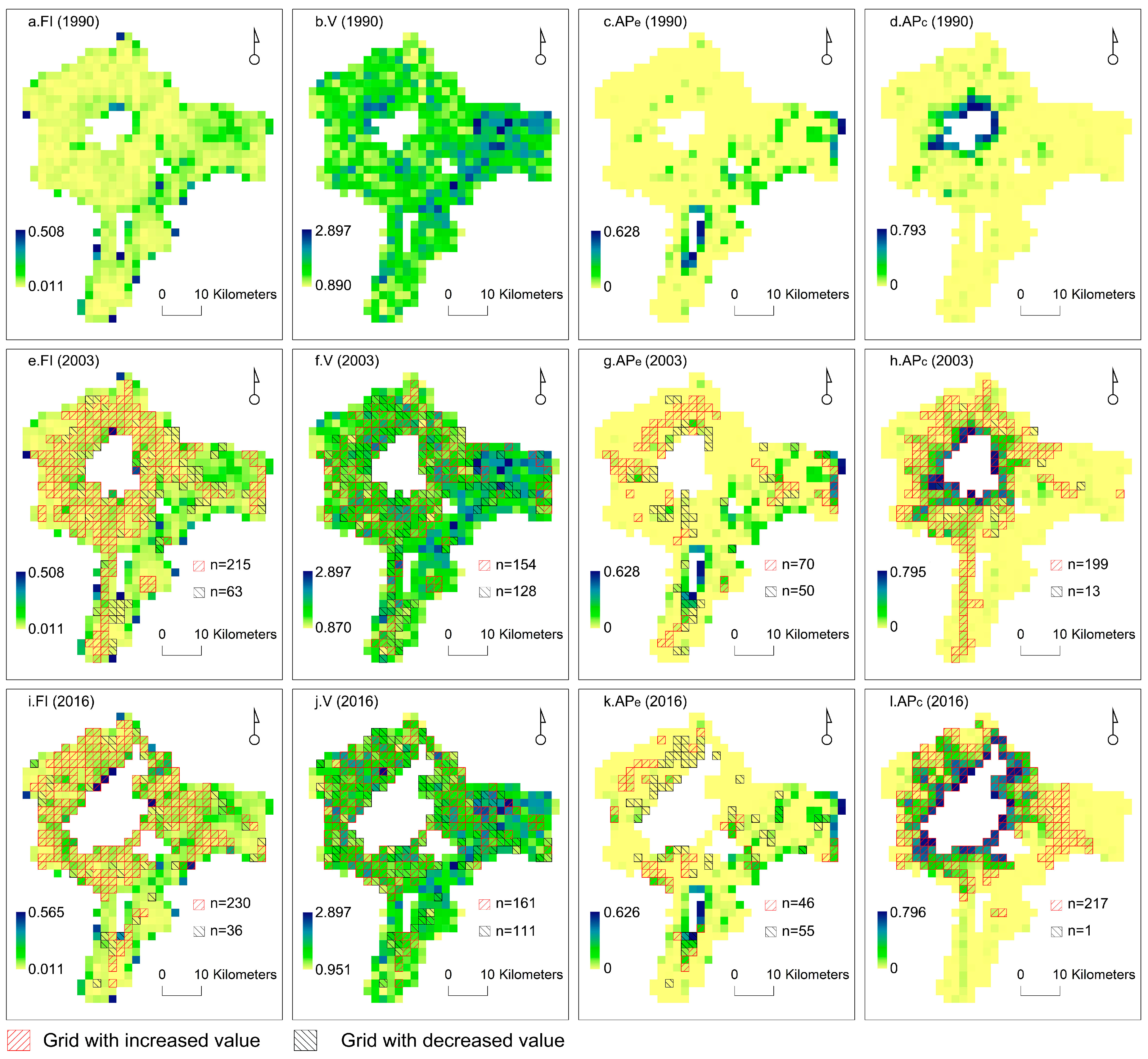
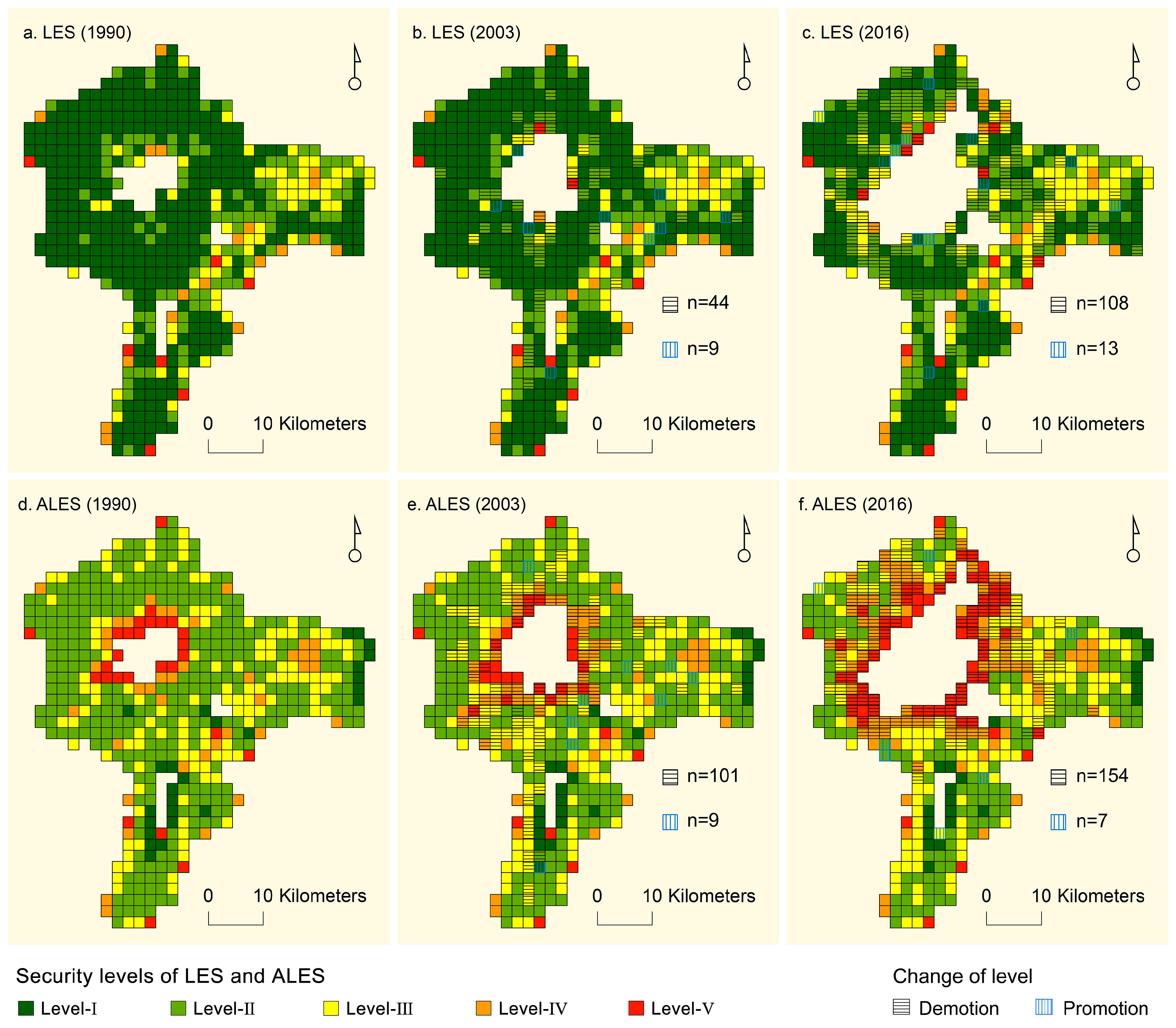
| Land Use Category | Abbreviation | Connotation |
|---|---|---|
| Central urban area | CUA | The continuous built-up region around the urban core. |
| Urban construction land | UCL | Central urban area, as well as transportation land, industrial land, mining land and urban communities outside of the central urban area. |
| Rural settlement | RS | Rural residential land. |
| Cultivated land | CL | Rainfed land, irrigated land and paddy land. |
| Forest land | FL | Forest, shelterbelt and shrub land. |
| Grassland | G | Natural and artificial grass land. |
| Water | W | Rivers and reservoirs. |
| Study Period | Converted from | Converted to | Total Converted Area | |||||
|---|---|---|---|---|---|---|---|---|
| UCL | RS | CL | FL | G | W | |||
| 1990–2003 | CL | 9940.30 | 1642.91 | 109,455.78 | 777.44 | 112.62 | 476.11 | 12,949.38 |
| FL | 437.40 | 15.69 | 943.81 | 22,768.42 | 12.06 | 10.13 | 1419.09 | |
| G | 243.36 | 0 | 86.54 | 0 | 337.65 | 0 | 329.90 | |
| W | 187.79 | 6.97 | 351.87 | 65.78 | 53.77 | 9241.72 | 666.18 | |
| 2003–2016 | CL | 23,711.04 | 841.56 | 86,161.02 | 1120.98 | 40.04 | 181.38 | 25,895.00 |
| FL | 200.21 | 8.74 | 222.23 | 23,204.81 | 0 | 0 | 431.18 | |
| G | 108.33 | 0 | 192.67 | 0 | 217.02 | 50.86 | 351.86 | |
| W | 523.89 | 0 | 254.06 | 26.37 | 0 | 8948.38 | 804.32 | |
| Value of LES | Security Level | ||||
|---|---|---|---|---|---|
| V | IV | III | II | I | |
| LES | (0.22,0.58) | [0.58,0.77) | [0.77,0.87) | [0.87,0.93) | [0.93,1) |
| ALES | (0.12,0.63) | [0.63,0.81) | [0.81,0.92) | [0.92,1.09) | [1.09,1.41) |
© 2018 by the authors. Licensee MDPI, Basel, Switzerland. This article is an open access article distributed under the terms and conditions of the Creative Commons Attribution (CC BY) license (http://creativecommons.org/licenses/by/4.0/).
Share and Cite
Yu, D.; Wang, D.; Li, W.; Liu, S.; Zhu, Y.; Wu, W.; Zhou, Y. Decreased Landscape Ecological Security of Peri-Urban Cultivated Land Following Rapid Urbanization: An Impediment to Sustainable Agriculture. Sustainability 2018, 10, 394. https://doi.org/10.3390/su10020394
Yu D, Wang D, Li W, Liu S, Zhu Y, Wu W, Zhou Y. Decreased Landscape Ecological Security of Peri-Urban Cultivated Land Following Rapid Urbanization: An Impediment to Sustainable Agriculture. Sustainability. 2018; 10(2):394. https://doi.org/10.3390/su10020394
Chicago/Turabian StyleYu, Dan, Dongyan Wang, Wenbo Li, Shuhan Liu, Yuanli Zhu, Wenjun Wu, and Yongheng Zhou. 2018. "Decreased Landscape Ecological Security of Peri-Urban Cultivated Land Following Rapid Urbanization: An Impediment to Sustainable Agriculture" Sustainability 10, no. 2: 394. https://doi.org/10.3390/su10020394
APA StyleYu, D., Wang, D., Li, W., Liu, S., Zhu, Y., Wu, W., & Zhou, Y. (2018). Decreased Landscape Ecological Security of Peri-Urban Cultivated Land Following Rapid Urbanization: An Impediment to Sustainable Agriculture. Sustainability, 10(2), 394. https://doi.org/10.3390/su10020394




